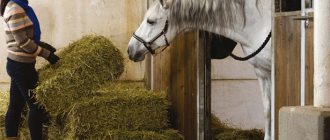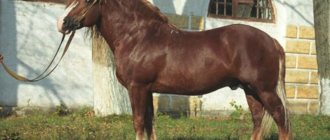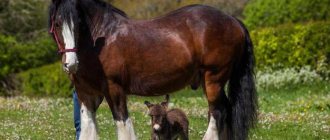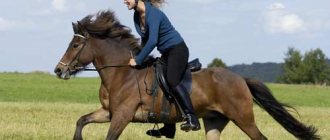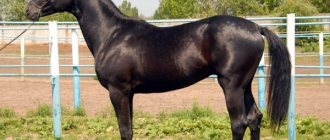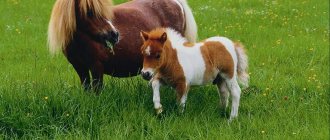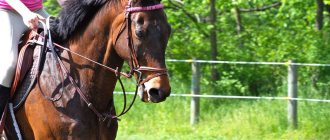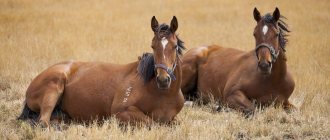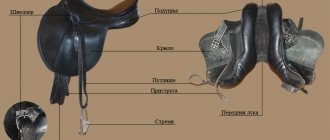Author Peter Deryabin
06/30/2010 18:00 (Updated: 02/13/2020 10:51)
Zoosphere » Veterinary » New items
Horses, like all other living beings, also, unfortunately, get sick. And then special equine veterinarians come to their aid. Of all branches of animal medicine, equine veterinary medicine is considered one of the most promising, and, at the same time, one of the most difficult. After all, you have to deal with a patient weighing several hundred kilograms and not at all of an angelic character.
How to treat Lymphangitis in horses
It is not surprising that the profession of “horse doctor” is one of the most dangerous and extreme.
anthrax
This disease can affect not only horses, but also humans. It occurs in those areas where there are all the conditions for the disease. In animals, the disease progresses very quickly, and in most cases there is no sign that the horse is unhealthy. Sometimes symptoms of an ulcer may include:
- colic in horses;
- constipation;
- bloody diarrhea.
It is almost impossible to stop the course of the disease. After some time, the animal still faces death.
Skin eczema
If you neglect to maintain cleanliness and order in the stables, the horses' skin will be subject to constant irritation, which sooner or later can develop into a chronic stage, that is, eczema. Despite the fact that eczema is not an infectious disease, the horse must be isolated during treatment, as its behavior can be nervous and even aggressive.
Symptoms:
- the horse began to twitch because it could not scratch all the affected areas of the skin;
- the skin dries, wrinkles appear, sometimes a crust and rash appear;
- appetite worsens, body weight decreases.
Viral infections
Perhaps one of the most widespread and causing serious damage to agricultural activities are viral diseases of horses. However, over the past few years, virologists have managed to achieve a major breakthrough in studying methods of combating pathologies that arise in horses.
Flu
Horse flu manifests itself in the form of an acute inflammatory process in the respiratory system of the animal, a depressed and feverish state, and a dry cough. If left untreated, the flu quickly develops into pneumonia.
The disease does not reveal itself in any way for 5-6 days. At the first sign, the horse is isolated and switched to easily digestible food. In case of complications and the appearance of a bacterial infection, the animal will require a course of antibiotics.
While recovering, the horse acquires immunity to viral infections, the effectiveness of which continues over the next year. After which the horse will need a vaccine.
Rhinopneumonia
An acute viral disease that occurs in the form of edema of the mucous membranes and lungs, as well as the appearance of conjunctivitis, is called rhinopneumonia. It can be found under such names as viral abortion of mares and genital exanthema. Most often, it is young individuals under one year of age who become infected. The virus is transmitted through urine, sexual intercourse, dirty food, liquid and saliva.
There is currently no effective treatment for rhinopneumonia. As a preventative measure, cephalosporin antibiotics and strict adherence to sanitary standards are used. The cured animal develops immunity that lasts six months.
Viral anemia
Viral anemia is an infectious disease that causes disturbances in the activity of the heart, blood vessels and the process of hematopoiesis. Anemia is transmitted through saliva, the blood of a sick animal and a blood-sucking insect. The young body of the foal is not able to cope with this disease, therefore, as a rule, it dies.
The main symptoms of viral anemia are lethargy, feverish attacks and sudden weight loss.
If the virus is diagnosed, the animals are quarantined. Infected horses are euthanized and the entire premises are thoroughly disinfected. The quarantine is lifted after 90 days, provided that no sick animals were found during this period.
Infectious encephalomyelitis
Another viral disease that occurs in an acute form is infectious encephalomyelitis. Has a detrimental effect on the central nervous system and gastrointestinal tract of the horse. May progress to jaundice.
The asymptomatic period lasts from 15 to 40 days. After which the animal’s temperature rises, appetite decreases, depression and incessant yawning occur.
The infected horse is isolated in a spacious and dark place. For several days, sodium sulfate is administered through the nose twice a day and intravenous injection with methenamine.
Rheumatism
Rheumatic leg inflammation can affect one hoof or all four at once. The development of this non-contagious disease can be caused by errors in nutrition or care, frequent mechanical damage, or genetic hereditary predisposition.
What symptoms indicate the development of rheumatism:
- the horse's body temperature rises;
- it is difficult for the animal to stay on its feet, it increasingly takes a sitting or lying position;
- outwardly it is noticeable that the joints are enlarged, and upon palpation they become even more painful.
Wetweed in horses
Midling, or prickly heat, most often develops due to the fact that the conditions in which the horses are kept do not meet the norm. For example, the litter is not changed on time. Externally, the disease manifests itself in the form of cracked skin and wounds, which can later turn into ulcers. Most often, biting midge develops on the legs, just like scabies. If treatment is not started on time, there is a high probability that the wound will become infected and inflammation will begin. In this case, the treatment will be not only local, but also complex, since antibiotics will be required.
How to recognize biting midge at the very beginning?
- The horse alternately raises its hooves, and tries to keep its leg bent for as long as possible.
- Externally, you can observe modified skin, wounds appear that can bleed and fester
Non-communicable diseases
Almost every second horse is susceptible to diseases of the respiratory and digestive systems. Simple therapeutic measures will help restore the health of the animal.
Colic
Since the horse is one of the representatives of herbivores, it perfectly absorbs fiber. An excess of this substance (often the source of which is poor-quality food) leads to disruption of the digestive system. The main symptoms that help identify the occurrence of colic in a horse are pain in the diaphragm.
As a rule, every horse encounters a mild form of this disease. If pain persists, you should immediately contact your veterinarian. Treatment consists of a pain-relieving injection and a healthy eating plan.
Esophageal blockages
The special anatomical structure of the horse’s digestive system provokes the occurrence of pathologies associated with the functioning of the stomach, esophagus and intestines. The cause of the pathology is clogging with feed mass. This process can occur once or occur chronically.
Symptoms of esophageal blockage appear instantly - the horse stretches its muzzle and tries to clear its throat. Sometimes you can observe gagging and saliva leaking from the mouth.
Treatment is reduced to a fasting diet lasting 24 hours, an injection is given with substances such as acepromazine and xylazine.
Respiratory diseases
This group of diseases occurs due to improper care, an incorrectly selected treatment plan for colds and complications arising due to an infectious disease. Dust and lack of fresh air provoke the development of asthma in horses.
To cure an animal, it is necessary first of all to identify the cause of the disease, and then eliminate it. To ease the course of the disease, the equid is prescribed expectorants that allow the respiratory organs to function better, and herbal inhalation is prescribed.
Hoof pricks (naminas)
It often happens that an animal steps on a sharp object with its hoof; similar hoof diseases in horses are not uncommon.
This happens especially often in unskilled individuals. Naturally, inflammation may develop in the place where the splinter is located, which will interfere with normal walking. Also, the horse can simply overwork and bruise its limbs, which also significantly worsens the quality of life. Let's find out how to understand that an animal has formed a namin, or a prick:
- lameness appeared, gait worsened;
- joints become inflamed.
Parasitic diseases
Separately, we should dwell on parasitic diseases of horses, which can occur without characteristic symptoms, but ticks, helminths and other parasites living in the animal’s body will negatively affect its well-being and productivity.
Next, we will look at several of the most popular parasitic diseases in horses, which necessarily require appropriate treatment.
Gastrophyllosis
This disease is caused by gastrophylla larvae, which emerge from eggs laid by gadflies on the horse's fur and skin. After hatching, the larvae quickly penetrate the horse's digestive tract and settle in the stomach and rectum (Figure 7).
Fuse (shortness of breath)
This condition is usually diagnosed already at the stage when it develops into the category of chronic diseases. Its development occurs due to the fact that some alveoli in the lungs stop working as they become overgrown with connective tissue. Often a fuse occurs against the background of untreated bronchitis or any other disease associated with damage to the respiratory system, most often the lungs. The development of fuse will be accompanied by a lack of ventilation in the stalls.
Symptoms:
- unproductive dry cough;
- heavy shallow breathing.
Horse examination results.
Animals are considered sick if one of the following indicators is present:
- detection of trypanosomes in smears from the source material, detection of clinical signs characteristic of breeding disease (plaques, paresis, paralysis of the lips, ears, buttocks, characteristic depigmentation, swelling of the labia, etc.) with negative results of microscopic and serological examination;
- obtaining a positive serological test;
- obtaining a doubly questionable serological test.
The following horses are considered suspicious for the disease:
- having unclear clinical signs with negative results of serological tests, having been in mating with patients;
- who gave a questionable result at the RSC once during a three-time study. The horses are tested again for breeding disease using serological methods after 30 days.
Differential diagnosis. Incidental disease is differentiated from su-aura (in addition to the clinic) by examining peripheral blood for the presence of trypanosomes and infection of laboratory animals.
Treatment. Sick and suspected horses are treated. Before starting treatment, specialists need to weigh the horses or determine their weight by measurement, using the following calculation: for draft horses, the weight in kilograms is equal to the chest circumference in centimeters multiplied by 5.3, minus 505; for horses of heavy breeds, the weight in kilograms is equal to the chest circumference in centimeters, multiplied by 6.4 minus 689.6. Chest circumference is measured along a line touching the back corners of the shoulder blades. By measuring the weight is determined with an accuracy of 18 kg.
For treatment, Naganin is used, which is administered intravenously in therapeutic doses in a 10% dilution in physiological solution, at a dose of 0.01-0.015 per 1 kg of horse body weight. The second intravenous administration is given to horses 1-1.5 months after the first. In order to avoid complications (swelling of the prepuce, lips, sore hooves, etc.), horses are prescribed a long drive or ride (until light sweating) 2-2 days before treatment, as well as for 7-10 days after infusion of Naganin. 3 times a day.
In no case should you resort to reducing the dose of Naganin for fear of causing the above complications, due to the fact that the reduced dose not only does not cure the horse, but, on the contrary, creates races of trypanosis that are resistant to Naganin, the fight against which is extremely difficult.
Horses subjected to treatment remain under observation for a year and can be considered recovered if, after examining them three times with all diagnostic methods in the tenth, eleventh and twelfth months after treatment, no indications indicating a relapse of the disease are found.
In case of relapse of the disease, combination therapy is used, i.e. In addition to Naganin, novarsenol or antimony is administered at a dose of 0.005 g per 1 kg of weight. The infusion of these drugs is carried out according to the scheme as in the treatment of su-aura, namely on the first, tenth and sixteenth days Naganin, and on the fourth, seventh and thirteenth days novarsenol at a dose of 0.005 per 1 kg of live weight.
Recently, new trypanocidal agents have been studied and proposed for practice - fuadin, antimozan (antimony drugs) and sovarsen (instead of novarsenol). Sovarsen (chlorarsen) in combination with Naganin is used according to the following scheme: on the first and tenth day of treatment, Sovarsen at a dose of 0.002-0.004 g per 1 kg of body weight into a vein; on the 4th day of treatment - Naganin at a dose of 0.01-0.015 g per 1 kg of body weight into a vein.
Fuadin in combination with Naganin is used intravenously at the same time. Fuadin at a dose of 0.1 ml per 1 kg of weight is diluted in half with physiological solution and Naganin is added at a dose of 0.01 per 1 kg of weight; the course of treatment is seven days (first, fourth and seventh).
Sick horses are provided with improved feeding and management; In addition to specific treatment, symptomatic treatment (cardiac and other drugs) is also prescribed.
Mares treated, after the disappearance of clinical symptoms of the disease, are artificially inseminated or mating is organized, selecting separate stallions for them, which are treated as a preventive measure with Naganin at a dose of 0.01 g per 1 kg of body weight.
A group of mares suspected of infection is artificially inseminated or paired with a specially selected stallion, prophylactically treated with Naganin.
Hoof crack
Deep cracks in the stratum corneum of the hoof reach the soft tissues and cause severe pain when walking. The horse begins to limp. Hoof cracks can become infected. In such cases, treatment consists of widening the entrance to the crack as much as possible and rinsing it well. Then the edges are carefully aligned with a rasp. Sometimes it is necessary to fill the crack with a special filler or fix it until the entire stratum corneum grows back.
Treatment
The main drug used in the treatment of breeding disease is Naganin, which acts directly on the causative microorganisms. It is produced in powder form - before administration, it is necessary to calculate the dosage for each horse based on its weight (0.01-0.15 per 1 kg) and dissolve the drug in saline.
Incidental disease requires long-term treatment with specific drugs
Step-by-step instructions for preparing Naganin solution
Step 1.
Using a beaker or a special flask with marks, measure the required volume of saline solution.
Naganin
Step 2.
Pour the solution into a container and boil it on a primus stove or heat it in another way.
Boil the solution
Step 3.
Pour the required amount of Naganin powder into the liquid. To avoid increasing the volume of liquid, it is better to do this in two steps. Make a mark on the container for the level of the solution, then pour the part into a sterile container, pour out the powder, and after it is completely dissolved, add saline to the previously made mark.
Add Naganin
Step 4.
The drug dissolves slowly, remains on the surface for a long time and sticks to the walls. If there is sediment in the finished solution, it must be filtered and sterilized with flowing steam.
The drug dissolves slowly
Step 5.
Inject the prepared solution into horses intravenously, strictly observing sanitary and hygienic rules.
Administer the drug to the horse
Naganin is a long-acting drug, so one infusion is enough for treatment - the next one is given 30-40 days later. The procedure may cause side effects such as tissue swelling and hoof pain. To prevent them, you need to give the horses a short walk or ride 2 days before the start of therapy (until light sweating appears). If you do not have the necessary skills, it is better to entrust the administration of the drug to a specialist - if it is treated incorrectly, unpleasant consequences may occur.
In modern veterinary practice, Naganin is often replaced with new agents to combat trypanosomes - sovarsen, fuadin, antimozan. It is strictly not recommended to change the treatment regimen or specific medications on your own - this should be done by a specialist.
Random disease can cause relapses
Individuals who have been treated must be under veterinary supervision for a year. They are considered healthy only if, after three tests, there are no signs of the disease. In a dysfunctional farm, it is necessary to regroup and keep an accurate record of the breeding individuals that are mating.
In case of a repeated outbreak, novarsenol or antimony is added to specific drugs according to a certain scheme. Horses receiving specific treatment for breeding disease require high-quality nutrition and, in some cases, symptomatic therapy (cardiac medications and other medications).
Scabies
Inflammation of the skin caused by mites. Affected areas are limbs, neck, head. Symptoms include: stamping feet, itching; hair falls out on the affected areas and scabs form; rash, itching; the skin peels off and lumps appear.
Treatment is carried out by applying heated Wagenfeld ointment and paraffin oil. Used as medicines and ointments against parasites. Now you know what horses get sick with, and you can understand that the animal is not healthy. The owner’s task is to ensure that the horses remain healthy and do not get sick.
Infectious
They arise due to the entry of pathogenic microbes into the animal’s body. They worsen the horse's condition and, without treatment, lead to death. Many of the infections are transmitted to humans. Contagious and very dangerous diseases include: anthrax, rabies - for these the horse is given a serum to prevent the disease, and a vaccination. Common infectious diseases include:
- glanders (cannot be treated, the horse is eliminated)
- washed (treatment lasts 2-3 weeks, the animal is in quarantine)
- influenza (preventive vaccination is carried out)
- rhinopneumonia or herpes (vaccination is carried out)
- viral anemia (highly contagious, horses are isolated and destroyed)
- encephalomyelitis (treatable if the form is not violent, otherwise death occurs within two days)
- Incidental disease (treated with antimicrobials and symptomatic medications)
Foot diseases
They often develop as a result of improper care and poor living conditions.
Trauma and injury to the hooves often occur. Foot diseases include the following:
- capelet
- corolla serif
- hoof shoeing
- sole injection
- rheumatic inflammation
- hoof cracks
A more common disease, biting midges are rotten and wet areas from the hoof to the fetlock joint; they need to be cleaned and treated with antiseptic agents. Myoglobinuria is also isolated - it develops as a result of excessive stress, rest is given and symptomatic treatment is carried out.
Gastrointestinal diseases
They arise due to poor quality food and poor diet. Treatment is carried out by adjusting the animal's feeding. The most popular disease is colic. This is a dangerous disease for a horse that can result in death, so urgent assistance should be provided in the form of intravenous analgin, internal castor oil, and abdominal massage.
Infestations
The animal is affected by parasites of various natures: ticks, fleas, helminths and the like. The most common are helminthiasis - this is infection with various worms: tapeworms, nematodes, flukes and others. Symptoms of helminth damage are similar: lethargy, loss of appetite, constipation or diarrhea, anemia. Treatment is carried out with anthelmintic drugs.
What does healthy look like?
Recognizing horse diseases, the treatment of which depends on humans, is quite simple if you know the physiometric indicators of the animal.
The characteristics of a healthy horse are:
- Normal behavior. Good appetite, no lameness, interested in the offered delicacy.
- Smooth breathing at rest. As you exhale, the ribs make one smooth movement. Respiration rate – 8-16 times per minute.
- The heart rhythm is calm, the norm is 40-50 beats/min.
- The skin is elastic. If you grab it at the shoulder and let go, it should immediately smooth out. There are no bumps or hard areas, and the coat is silky and free of abrasions.
- The mucous membranes of the nose, eyes and gums are clean. There is no discharge or redness, the teeth are in good condition.
- Stools are normal, frequency 2-4 times a day.
- Normal rectal temperature is 38-38.5 degrees.
- The hooves are healthy, there is no smell or discharge.
If the temperature is slightly reduced and the heart rate is increased, this is not a sign of illness. The temperature drops as the horse defecates and the heart rate increases due to excitement. But if the temperature rises to 38.9 degrees, it is necessary to show it to the veterinarian.
Signs of a sick person
A sick animal has characteristic signs of the disease:
- Deviations in behavior. The horse is either too excited, to the point of aggressiveness, or lethargic and apathetic.
- No appetite. She either eats little or doesn’t eat at all, drinks little or, conversely, drinks a lot. Refuses treats.
- Breathing is intermittent. When she exhales, the movement of the ribs is disrupted, and the walls of the abdominal cavity take part in the breathing process.
- Dry skin. When captured, it diverges slowly, and dulling of the fur is noted.
- The mucous membranes turned red and inflamed. There is discharge from the eyes and nose, coughing and sneezing.
- The chair has changed. It has become more frequent, watery and smelly, or, on the contrary, has been absent for a long time.
- Body temperature is increased.
- The movements are of a different nature. The animal limps, makes few movements, and may fall onto its croup or lie down, which is not typical for a healthy horse.
In this case, only a veterinarian will help, who will establish a diagnosis and prescribe the correct treatment. You cannot self-medicate, as this will harm the health of the animal.

